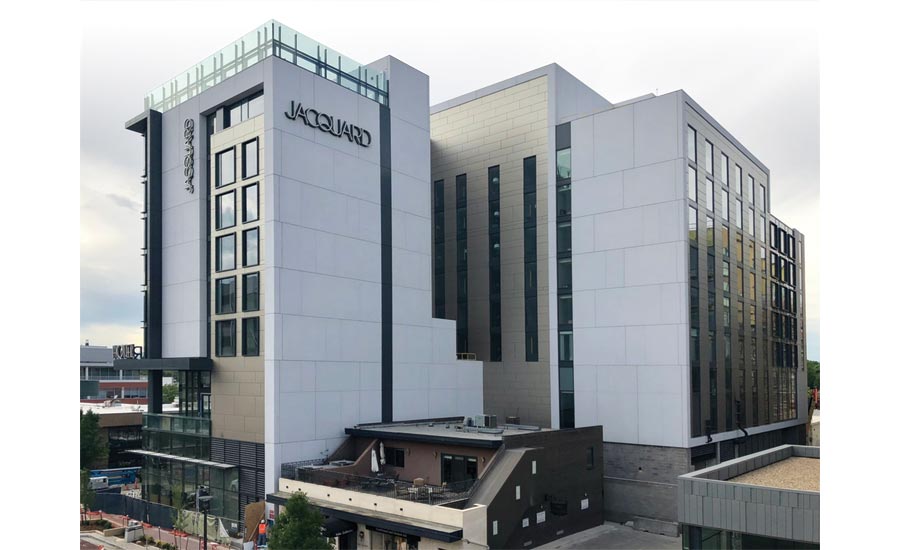Prefab Wall Systems With EIFS
The Next Article in Relation to a New Type of Prefab Wall System Blooming in North America.


Thin brick is applied to a curtain wall panel in the panel plant.

Metal panels and windows being installed in the panel manufacturing facility.

Tile curtainwall panels were utilized on the City Hyde Park Apartments, Chicago.

Home 2 Suites by Hilton, in Philadelphia, used Sto Panels for the exterior skin.





If you’ve ever purchased ready-to-assemble furniture at IKEA or if you’ve put together toys on Christmas Eve you have been involved with prefabricated products. Partially constructed products that are ready for assembly are becoming more common in our daily lives. The prefabrication concept in construction is growing in this country and around the world as the labor force and the number of skilled workers continues to decline. Even before this labor shortage, construction productivity had lagged behind almost all other industries.
According to a recent McKinsey & Company study, since 1945 productivity in manufacturing, retail, and agriculture has grown by as much as 1,500 percent while productivity in construction has barely increased at all. The prefabricated curtain wall panel business can provide one of the answers to increasing productivity.
A New Platform
While prefabricated curtain walls are not a new concept, changes are necessary to implement new technology. A new way of thinking would give the industry a platform to grow from as it tackles the challenges of today’s construction market. Based on past building practices, some of these changes would be radical. But the first place to start would be to utilize innovative technology.
New Technology
As the world entered a new century it experienced many new technological advancements. Some of this knowledge has been implemented by the construction industry. BIM has made a significant difference in the way buildings are designed and built. This software enables designers or fabricators to design buildings and wall panels in a 3-D model format. Changes can be made and viewed in real time which allows for multi-disciplinary collaboration between all parties involved in the construction process for better insight and coordination.
Once the BIM model has been approved, panel specs can be sent to the panel manufacturing facility to begin assembly. As panels are completed, bar codes or QR codes can be affixed to panels to insure the proper panel will go into the proper position on the structure. With this innovation the jobsite superintendent can use his iPad to scan the code and quickly see the panels’ installation positions.
Digitization has also contributed to an improved construction process as state-of-the-art cameras and lasers provide for precise measurements at the jobsite which can then be transmitted to the panel plant insuring accuracy during production. Additionally, drones can be used to gather information in areas of the project that are out-of-reach. In the future it may be possible to install sensors in the panels to check performance or problems, thus creating Smart walls. These technologies can be used to improve the construction as well as the manufacturing process.
Manufacturing
It appears that the prefabricated curtain wall business is moving from a construction mentality to a manufacturing mindset. There are advanced methods for the construction of wall panels beginning with a facility dedicated to building panels in a controlled environment. This designated facility should have the necessary stations, tables, jigs, and cranes for the assembly process with BIM modeling also providing a key element in the production of the panels. The more advanced shops may also utilize CNC machines.
In the future, the use of cold-formed steel fabricating and robotics may be part of the manufacturing process. Also, suppliers may be able to adjust their products to meet the needs of the manufacturing environment. However, once the manufacturing process is in place then the facility must be kept busy to achieve a balance between production capacity and utilization. This is a substantial change from the prior construction mentality to a modern manufacturing mindset.
New Concepts
So while the use of panels may not be new to construction there are some new approaches for marketing the concept. In the early stages of the industry the EIFS and stud manufacturers along with the contractors were active in the promotion of the business. Today, the contractors committed to the business are out promoting. On the vendor side Dryvit and Sto have programs in place to support the prefab panel business. Each company has its own way of marketing the panel business.
Dryvit has adopted a more traditional approach as panels are a way to sell more material. According to Rick Bunting, the company’s director of sales, Building Materials Group, their panel program is called Tech 21. It offers three types of panel systems options: Fedderlite, Metalite, and Outsulite. These systems offer different solutions for a variety of construction conditions. All three use EIFS products as the core but offer a variety of finish options ranging from traditional EIFS finishes to their Newbrick to specialty finishes that look like stone or metal.
Dryvit has a network of applicators that can build panels. The Outsulite panel is the original stud, sheathing, and EIFS assembly. But company’s Fedderlite system, which is a lighter weight assembly is gaining ground, as it’s simple to build and can be used in a variety of applications from new construction to renovation projects. The manufacturer provides promotion and support of this business by offering marketing help, technical assistance, and a special warranty with their applicator partners.
An innovative method of promoting the panel business is being utilized by Sto. The company’s approach is called Sto Panel. They first sell the concept of prefabricated curtain walls and then they offer the customer any design options or cladding they desire. There are virtually no limits as brick, stone, metal, glass or EIFS can all be used.
The manufacturer has also developed a network of over thirty affiliates throughout North and South America. These affiliates are prefabricated curtain wall manufacturers that have dedicated facilities for producing panels in a controlled environment. They have created a team approach to the business as the companies freely share best practices with one another. If one of the affiliates needs assistance on a project another member will be quick to jump in and help them.
The company’s strategy is not only about selling its buckets and bags but in promoting the utilization of the panel concept in construction.
Methodologies Changed
Building panels as part of the entire building envelopment is somewhat of a new methodology for the panelization business. Today the new class of panel producer is much more involved in the building’s design than in the past. Their scope of work and responsibility has expanded to include the design, the fabrication, and the installation.
The design covers the engineering of the panels, the specifications, and the detail drawings. It may also cover other aspects of the construction in order to improve communication with all parties involved with the project.
The fabrication phase is the building of panels and may include several trades as different claddings may be used or if windows are built into the panel. The installation portion of the job would include logistics as panels are moved from the plant and onto the structure. The final step of the project includes the waterproofing of the panel using either a sealant or a gasket system to seal the joints.
Another benefit of the new methodology is the control over quality. The factory-controlled environment and a manufacturing mentality are very conducive to quality processes and procedures. As the panels are systematically produced, if called for, a third-party inspection or testing can be completed in the plant before the panels are shipped to the jobsite which greatly reduces jobsite inspection time.
A Bright Future
Not all companies building prefabricated curtain wall panels today are following the new methodologies but the ones that do will have a bright future. Afterall, they will be providing their customers with a finished product with fewer errors, a more predictable construction timeline, and cost savings as compared to on-site construction. The panel manufacturers and their partners will be creating a demand for an unmatched wall product.
At the recent Advancing Prefabrication Conference held in Dallas, with more than 500 people in attendance, it was reported that today’s jobsite efficiencies per man are about 60 percent whereas efficiencies in a manufacturing facility were 90 percent. This along with the labor shortage clearly provides a case for more prefabricated products and system.
Companies such as Turner Construction, Marriott, and HCA are just a few that have embraced this technology. Others will be joining them as more construction companies embrace the new technology that curtain walls can provide the building industry.
Looking for a reprint of this article?
From high-res PDFs to custom plaques, order your copy today!











